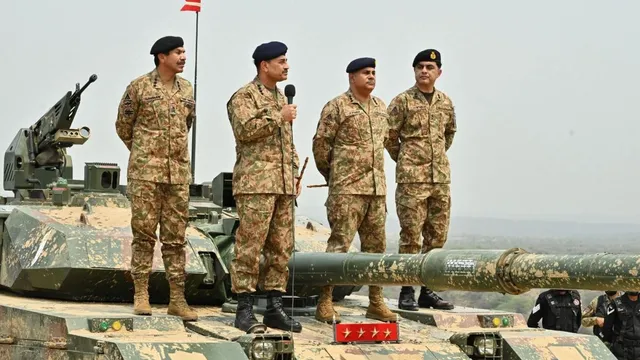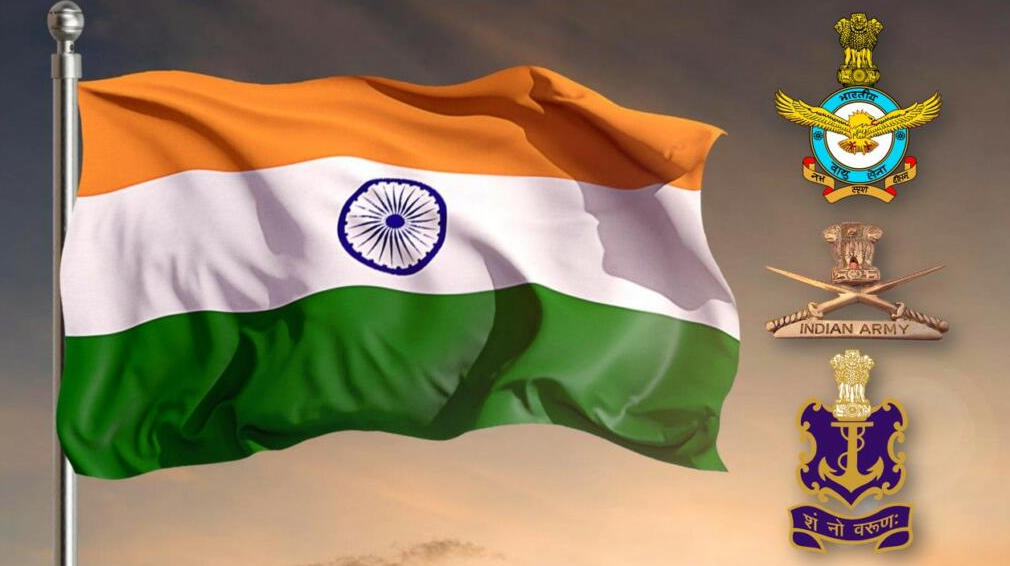In an unflinching show of strength and precision, the Indian Armed Forces have launched a decisive retaliatory strike under Operation Sindoor, targeting and annihilating nine key terror camps deep inside Pakistan and Pakistan-occupied Jammu & Kashmir (PoJK). The operation comes just two weeks after the cowardly Pahalgam terror attack that claimed the lives of 26 Indians and marks a clear red line – India will no longer tolerate terrorism emanating from across the border.
Retaliation With Resolve. Precision With Purpose.
Executed in the early hours of May 7, Operation Sindoor represents the most coordinated, high-impact counter-terror strike India has undertaken since the Balakot operation, only this time, all three services of the Indian military – the Army, Air Force, and Navy – moved in unison. The objective was crystal clear: Neutralize the roots of terror, dismantle operational hubs, and send a message that India’s patience has limits.

Nine Targets. One Message. Zero Tolerance.
According to senior Ministry of Defence officials, all nine locations were confirmed hubs of terror activity affiliated with globally designated terror outfits Jaish-e-Mohammed (JeM), Lashkar-e-Taiba (LeT), and Hizbul Mujahideen. These were not symbolic targets. These were operational nerve centres, training grounds, and launchpads for infiltration destroyed with ruthless precision.
The Arsenal of Accountability
The Indian Air Force unleashed Rafale fighter jets armed with SCALP cruise missiles and Hammer precision-guided munitions. Kamikaze drones – loitering munitions with unmatched lethality – eliminated targets with pin-point accuracy. Naval and ground-based intelligence enabled real-time coordination. Crucially, the operation avoided civilian infrastructure and Pakistani military installations, demonstrating India’s mature strategic calculus: Measured, focused, and deadly effective.
1:45 AM—The Night the Valley Rumbled, and So Did Islamabad
As Indian jets sliced through the night sky, the Kashmir Valley stood still. Loud explosions rocked Srinagar and beyond. Panic briefly filled the air but not from fear. From awe. From realization that India had acted not with words, but with might.
At dawn, the Indian Army’s official X (formerly Twitter) handle delivered the nation’s verdict:
“Justice is served. Jai Hind.”
The Targets: Nine Blows to the Terror Machine
–Markaz Subhan Allah, Bahawalpur (Pakistan)
JeM’s core command centre—home to Masood Azhar. Reduced to rubble.
–Markaz Taiba, Muridke (Pakistan)
Lashkar-e-Taiba’s founding cradle—birthplace of the 26/11 attackers. Erased.
–Sarjal/Tehra Kalan, Narowal (Pakistan)
Hidden JeM infiltration hub under a health facility. Exposed and eliminated.
–Mehmoona Joya Camp, Sialkot (Pakistan)
Hizbul Mujahideen’s school-based training site. Flattened.
–Markaz Ahle Hadith, Barnala (PoJK)
LeT’s staging post for Poonch-Rajouri operations. Neutralized.
–Markaz Abbas, Kotli (PoJK)
JeM enclave led by top commander Qari Zarrar. No longer operational.
–Maskar Raheel Shahid, Kotli (PoJK)
Veteran sniper camp—turned to dust.
–Shawai Nallah (Bait-ul-Mujahideen), Muzaffarabad (PoJK)
ISI-linked terror haven. Obliterated.
–Markaz Syedna Bilal, Muzaffarabad (PoJK)
JeM transit and advanced combat camp—with SSG links. Now history.

Retaliatory Fire or Empty Rhetoric? India Awaits Pakistan’s Next Misadventure
In the immediate aftermath of India’s decisive and coordinated strike under Operation Sindoor, panic and political tremors gripped Pakistan’s power corridors. The Indian offensive which was swift, targeted, and unambiguously aimed at terror infrastructure – has left Islamabad scrambling for a response. And as the dust settles on nine smouldering terror camps, Pakistan’s sabres are rattling louder than ever.
The Inter-Services Public Relations (ISPR), Pakistan’s military mouthpiece, confirmed strikes on key locations in Bahawalpur, Muridke, Kotli, and Muzaffarabad. With uncharacteristic haste, DG ISPR Lt. Gen. Ahmed Sharif Chaudhry condemned the strikes as “cowardly” and accused India of hitting civilian areas – a claim promptly dismissed by New Delhi as a deflection tactic rooted in fiction.
“Let me say it unequivocally: Pakistan will respond at a time and place of its choosing,” thundered Gen. Chaudhry during a hastily convened press conference, even as he acknowledged casualties – one child dead and twelve injured. It was a predictable script, one India has seen many times before.
Retaliation Begins: Ceasefire Violated, Civilians Targeted
True to its old playbook, Pakistan resorted to immediate, if scattered, military aggression along the Line of Control. Ceasefire agreements were violated as artillery shells rained on Indian border villages, leading to the tragic deaths of three civilians. India, acting with restraint but readiness, responded with “effective and proportionate fire,” inflicting casualties across Pakistani positions. Exact numbers remain undisclosed, but military observers confirm multiple Pakistani posts suffered damage.
This sudden escalation at the LoC proves one thing – when cornered, Pakistan retreats to chaos.
New Delhi’s Unflinching Message: Justice, Not War
Indian officials continue to stress that Operation Sindoor was not a declaration of war but a calibrated act of retribution for the Pahalgam massacre. “We struck with precision. No military or civilian targets unrelated to terrorism were touched,” a senior defence source reiterated. India’s posture remains one of calm resolve – a measured but unshakeable commitment to defend its sovereignty and citizens.
Meanwhile, nationwide security has been ramped up. Critical infrastructure, metro cities, and sensitive installations have been placed under heightened surveillance. Cyber agencies are actively scanning digital chatter for coordinated propaganda or sabotage attempts. Delhi is conducting simulation drills, preparing for any scenario.

Pakistan’s Strategic Crossroads- What Will It Risk Now?
India’s coordinated multi-service strike – land, air, and sea – has not just shocked Pakistan’s defence establishment; it has disrupted its strategic calculus. With nine terror facilities decimated, Pakistan now stands at a crossroads, weighing its next move.
Here’s what the road ahead looks like for a rattled Islamabad:
1. Military Retaliation: Risky, Limited, and Symbolic
Likelihood: Medium
Pakistan’s doctrine of “credible minimum deterrence” encourages swift retaliation. However, the Indian strikes—carefully avoiding civilian or military infrastructure, deny Pakistan a proportional military target without risking all-out escalation.
What we may see:
–Artillery duels and LoC posturing to placate internal audiences.
–Airspace violations or missile tests to demonstrate capability.
–More infiltration attempts in Rajouri, Kupwara, or Poonch.
However, with India’s demonstrated air superiority and political will, a deep incursion is unlikely. Pakistan knows the costs of escalation may be catastrophic and global sympathy is no longer guaranteed.
2. Diplomatic Escalation: The Perennial Victim Card
Likelihood: High
Pakistan has turned whining into an artform at the UN and OIC. This time too, expect a flood of diplomatic communiqués, emergency meetings, and staged outrage.
What to expect:
–Summoning foreign envoys to label the strike “unprovoked aggression.”
–Dramatic appeals to China, Turkey, and the Islamic world for statements of support.
–Pushing for a UN Security Council resolution – though success remains highly doubtful.
India, with its growing geopolitical clout and unambiguous evidence of terror origins, is well-positioned to blunt Pakistan’s attempts to internationalize the matter.
3. Asymmetric Proxy Warfare: Terror by Other Means
Likelihood: Very High
This is Pakistan’s most comfortable domain. It has long relied on non-state actors for plausible deniability. Following the 2016 Uri and 2019 Balakot strikes, Pakistan leaned into this strategy—and Operation Sindoor may provoke a similar response.
Anticipated actions:
–Fresh infiltration of heavily armed militants across the LoC.
–Sleeper cell activation in Jammu, Punjab, and other strategic zones.
–Cyber warfare aimed at disrupting Indian digital infrastructure.
–Coordinated propaganda campaigns to inflame internal unrest or discredit Indian institutions.
But India is no longer ill-prepared. Intelligence networks, both domestic and foreign, are already tracking chatter from ISI-linked groups. Counter-infiltration operations are ongoing.
4. The China Factor: Whispered Support, Visible Restraint
Likelihood: Moderate
Beijing is Pakistan’s “iron brother”—but also a global power walking tightropes in Taiwan, the South China Sea, and a faltering economic recovery. China may shield Pakistan diplomatically, but will likely avoid military entanglement.
Expect:
–Backchannel support, including satellite intel and logistics.
–Diplomatic cover at multilateral forums.
–Reinforced narrative alignment via Belt and Road allies.
However, China does not benefit from South Asia descending into war—especially not with CPEC hanging in the balance. Expect strategic caution rather than reckless support.
5. Domestic Diversion: The Blame Game Begins
Likelihood: Certain
Pakistan’s civilian leadership is fractured, its economy in shambles, and its population restive. An external threat offers a convenient escape from IMF conditions, political instability, and food inflation.
Likely outcomes:
–Crackdowns on dissenting media and opposition under the pretext of national security.
–Hyper-nationalist television coverage engineered to whip up anti-India sentiment.
–Accusations that India is behind any new wave of domestic terror incidents—real or manufactured.
But even Pakistanis are asking questions. Who let the terror camps flourish? Why were India’s fighters unchallenged? And why is the military, flush with funds, unable to defend its own borders?

The Last Bit, India Has Rewritten the Rules
India’s Operation Sindoor is India’s response to no terror attack will go unanswered, and safe havens across the border are no longer beyond reach. Pakistan may rant and retaliate, but it must now confront a changed reality where Indian strikes are measured, legal, and devastatingly effective.
The question now is not if Pakistan will respond, but how long it can hide behind terror proxies before the world calls its bluff again.

